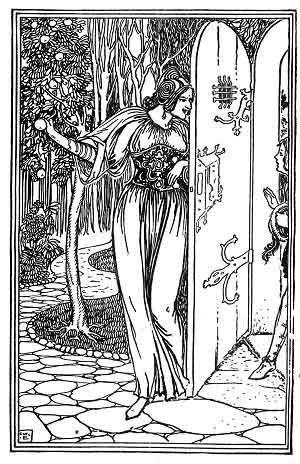 | ||
Sir Hugh is a traditional British folk song, Child ballad # 155, Roud # 73, a folkloric example of a blood libel.
Contents
Synopsis
Some boys are playing with a ball, in Lincoln. They accidentally throw it over the wall of a Jew's house (or castle). The daughter of the Jew comes out, dressed in green, and beckons to a boy to come in to fetch it. He replies that cannot do this without his playmates. She entices him in with fruit and a gold ring. Once he has sat down on a throne, she stabs him in the heart "like a sheep". There is much blood.
When the boy fails to come home, his mother concludes that he is skylarking. She sets out to find him, with a rod to beat him. From beyond the grave, the boy asks his mother to prepare a funeral winding sheet, and that he is "asleep". In some versions he asks that if his father calls for him, the father is to be told that he is "dead." In some versions the boy's corpse shines "like gold". In some versions the Jew's daughter catches the blood in a basin and puts a prayerbook at his head and a bible at his feet.
Commentary
The song has been found in England, Scotland, Canada, the US and, to a lesser extent, Ireland. It was still popular in the early nineteenth century. The title "Sir Hugh" or more commonly "Little Sir Hugh" should actually be called "Little Saint Hugh" since this is based on the story of Little Saint Hugh of Lincoln; the "little" is used to stop confusion with another saint of the same name, Saint Hugh, Bishop of Lincoln. Whilst it would appear that Hugh had merely fallen down a well whilst searching for his ball, because the well was located on Jewish property, stories of ritual killing soon developed and 70 Jews were arrested, 18 were hanged for refusing to take part in the trial, the remainder were pardoned.
In medieval times such anti-Semitic tales were common. Jews had been expelled from England in 1290, and did not return until 1658. It seems unlikely that crude propaganda would be deliberately concocted and spread in the late 17th century, since Britain had become a refuge for persecuted religious minorities. There is a tale that in 1255 a boy was kidnapped by Jews, and crucified. His body was apparently found in a well, and a blood libel was built around this and used to lynch and murder many Jews in medieval Lincoln, as part of one of the first pogroms in recorded history. The story appears in Annals of Waverley.
According to Roud and Bishop,
The subject matter, however, is disturbing, and reminds us that folklore is not always nice and cosy. Indeed, racists, xenophobes, political zealots and religious fundamentalists have always used legends, rumours, songs, jokes and other lore to support and spread their beliefs and to indoctrinate their young, and in particular to denigrate and stereotype outsiders and the victims of their bigotry.
The artist and poet Matthew Paris (fl. c 1217 - 1259) has a Latin fragment of this ballad in his Chronicle. Thomas Percy's Reliques (1783) has a version from Scotland. David Herd (1776) had a version, and so did Robert Jameison (1806).
The idea of a corpse speaking (sending thoughts) to the living occurs in the ballad The Murder of Maria Marten, The Cruel Mother (Child 20) and in The Unquiet Grave (Child 78). Gruesome killings are quite common in Child ballads.
Textual variants
Several Scottish versions have the boys playing with a ball in Scotland, and suddenly (and inexplicably) transferred to Lincoln later in the song. A version from Northamptonshire says the boy was killed "like a swine". A version from Northumberland sets the events at Easter. An American version of the early 20th century, by Nelstone's Hawaiians, collected on Harry Smith's Anthology of American Folk Music, replaces the Jewish villainess with "a Gypsy lady, all dressed in yellow and green."
There is an Anglo-Norman version (medieval French) and a fragment in Latin (Matthew Paris's "Chronicles").
Controversy
Early collectors were surprised to find evidence of a ballad featuring a blood libel, and they wrote entire books on the subject. James Orchard Halliwell wrote Ballads and Poems Respecting Hugh of Lincoln in 1849. In the same year, and unknown to Halliwell, Abraham Hume wrote the book Sir Hugh of Lincoln, or, an Examination of a Curious Tradition respecting the Jews, with a notice of the Popular Poetry connected with it.
One of the earliest professional recordings of the song was by A. L. Lloyd on "The English and Scottish Popular Ballads Vol 2" in 1956, produced by Kenneth Goldstein, himself a Jew. Another interpreter of the song, Ewan MacColl, described the ballad as "the barbaric functioning of medieval thinking".
Music
There was no printed tune for the ballad until Edward Francis Rimbault's "Musical Illustrations of Bishob Percy's Reliques of Ancient English Poetry" (1850).
